英语语言学第八章 语用学 pragmatics备课讲稿
- 格式:ppt
- 大小:168.00 KB
- 文档页数:70
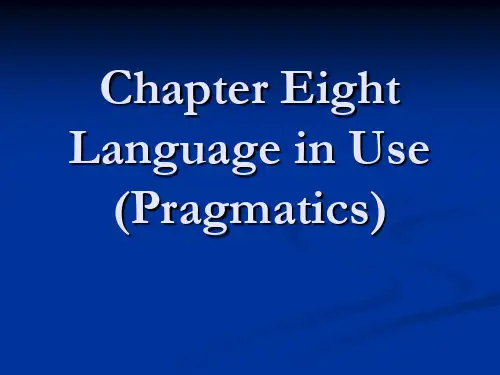
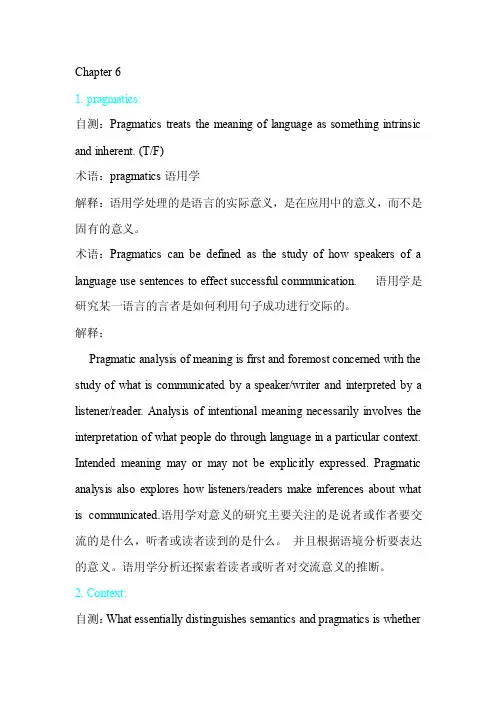
Chapter 61.pragmatics:自测:Pragmatics treats the meaning of language as something intrinsic and inherent. (T/F)术语:pragmatics语用学解释:语用学处理的是语言的实际意义,是在应用中的意义,而不是固有的意义。
术语:Pragmatics can be defined as the study of how speakers of a language use sentences to effect successful communication. 语用学是研究某一语言的言者是如何利用句子成功进行交际的。
解释:Pragmatic analysis of meaning is first and foremost concerned with the study of what is communicated by a speaker/writer and interpreted by a listener/reader. Analysis of intentional meaning necessarily involves the interpretation of what people do through language in a particular context. Intended meaning may or may not be explicitly expressed. Pragmatic analysis also explores how listeners/readers make inferences about what is communicated.语用学对意义的研究主要关注的是说者或作者要交流的是什么,听者或读者读到的是什么。
并且根据语境分析要表达的意义。

胡壮麟《语言学教程》笔记第8-9章Chapter 8 Language in Use1. 语义学与语用学的区别1.1 语用学(Pragmatics)Pragmatics is the study of the use of language in communication, particularly the relationships between sentences and the contexts and situations in which they are used.(语用学是研究语言实际运用的学科,集中研究说话人意义、话语意义或语境意义。
)1.2 区别Pragmatics is sometimes contrasted with semantics, which deals with meaning without reference to the users and communicative functions of sentences.(语用学主要研究在特定的语境中说话人所想要表达的意义,语义学研究的句子的字面意义,通常不考虑语境。
)2. 合作原则及其准则(Herbert Paul Grice)2.1. 合作原则(Cooperative Principle)说话人经常在话语中传达着比话语表层更多的信息,听话人也能够明白说话人所要表达的意思。
格莱斯认为一定存在一些管理这些话语产生和理解的机制。
他把这种机制称作合作原则。
2.2. 准则(maxims)数量准则(quantity)①使你的话语如(交谈的当前目的)所要求的那样信息充分。
②不要使你的话语比要求的信息更充分。
质量准则(quality)设法使你的话语真实①不要讲明知是虚假的话②不要说没证据的话关系准则(relation)所谈内容要密切相关方式准则(manner)要清晰。
①避免含糊不清②避免歧义③要简练(避免冗长)④要有序3. 言语行为理论(Speech Act Theory)---John Austin3.1. 施为句&叙事句(Performatives & Constatives)施为句是用来做事的,既不陈述事实,也不描述情况,且不能验证真假;叙事句要么用于陈述,要么用于验证,可以验证真假。
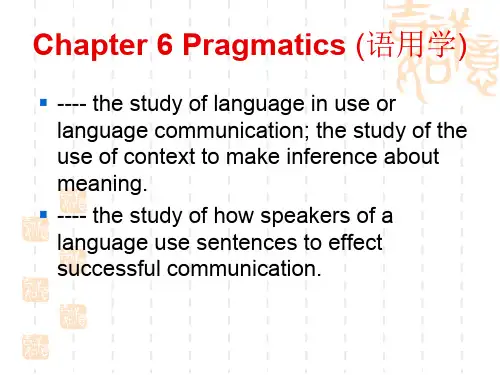
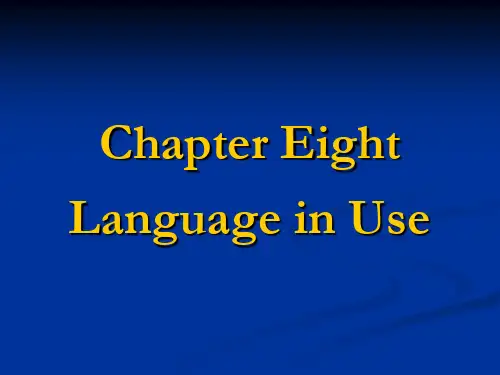
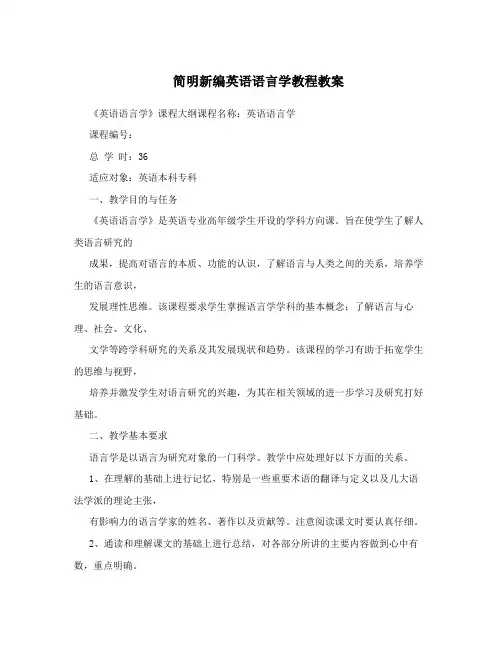
简明新编英语语言学教程教案《英语语言学》课程大纲课程名称:英语语言学课程编号:总学时:36适应对象:英语本科专科一、教学目的与任务《英语语言学》是英语专业高年级学生开设的学科方向课。
旨在使学生了解人类语言研究的成果,提高对语言的本质、功能的认识,了解语言与人类之间的关系,培养学生的语言意识,发展理性思维。
该课程要求学生掌握语言学学科的基本概念;了解语言与心理、社会、文化、文学等跨学科研究的关系及其发展现状和趋势。
该课程的学习有助于拓宽学生的思维与视野,培养并激发学生对语言研究的兴趣,为其在相关领域的进一步学习及研究打好基础。
二、教学基本要求语言学是以语言为研究对象的一门科学。
教学中应处理好以下方面的关系。
1、在理解的基础上进行记忆,特别是一些重要术语的翻译与定义以及几大语法学派的理论主张,有影响力的语言学家的姓名、著作以及贡献等。
注意阅读课文时要认真仔细。
2、通读和理解课文的基础上进行总结,对各部分所讲的主要内容做到心中有数,重点明确。
3、在学习过程中,注意联系、对比,将所学语言学理论与英语外语学习实际相结合。
4、注意提高运用理论解决实际问题的能力。
5、培养学生学术论文写作的能力,建构写作的理论基础及理论依据。
三、教学内容及要求:1.1 为什么学习语言?1.2 什么是语言?1.3 语言的本质特征1.3.1 任意性 arbitrariness1.3.2 二重性 duality1.3.3 创造性 productivity or creativity1.3.4 移位性 displacement1.4 语言的起源1.5 语言的功能1.5.1 信息功能 informative1.5.2 人际功能1.5.3 施为功能1.5.4 感情功能emotive1.5.5 交感性谈话1.5.6 娱乐性功能1.5.7 元语言功能1.6 什么是语言学?1.7 语言学的主要分支1.7.1 语音学phonetics1.7.2 音系学phonlogy1.7.3 形态学mprphology1.7.4 句法学syntax1.7.5 语义学semantics1.7.6 语用学pragmatics1.8 宏观语言学1.8.1 心理语言学1.8.2 社会语言学1.8.3 人类语言学1.8.4 计算语言学1.9 语言学中的一些重要区别1.9.1 “描写式”和“规定式”descriptive and prescriptive 1.9.2 “共时”和“历时”synchronic and diachronic1.9.3 “语言”和“言语”langue and parol1.9.4 语言能力和语言应用competence and performance1.9.5 “非位的”与“位学的”2.1 言语产生和言语感知2.2 言语器官2.3 音段、分化和标音法 2.3.1 音段和分化2.3.2 标音法2.4 辅音2.4.1 辅音和元音2.4.2 辅音2.4.3 发音方法2.4.4 发音部位2.4.5 英语中的辅音2.5 元音2.5.1 元音描写的原则 2.5.2 基本元音理论2.5.3 元音音渡2.5.4 标准发音中的元音2.6 协同发音和语音描写 2.6.1 协同发音2.6.2 宽式标音和严式标音2.7 音位分析2.8 音位和音位变体2.8.1 最小对立体2.8.2 音位理论2.8.3 音位变体2.9 音位过程2.9.1 同化2.9.2 音系过程和音系规则 2.9.3 规则顺序2.10 区别性特征2.11 音节2.11.1 音节结构2.11.2 响音阶2.11.3 音节划分和最大节首原则2.12 重音3.1 什么是词?3.1.1 “词”的三种含义3.1.2 词的识别3.1.3 词的分类3.2 词的形成3.2.1 语素和形态学3.2.2 语素的类型3.2.3 曲折变化和词的形成 3.2.4 音系学和形态学的对立3.3 词汇变化3.3.1 特有的词汇变化 3.3.2 音位变化3.3.3 形态-句法变化3.3.4 语义变化3.3.5 拼写的变化4.1 传统学派4.1.1 数、性、格4.1.2 时和体4.1.3 一致关系和支配关系4.2 结构主义学派4.2.1 组合关系与聚合关系 4.2.2 直接成分分析法 4.2.3 向心结构和离心结构4.3 生成学派4.3.1 深层结构和表层结构 4.3.2 标准理论及其后的发展 4.3.3 管辖、约束等4.4 功能学派4.4.1 功能句子观4.4.2 系统功能语法5.1 “意义”的意义5.2 指称论5.3 涵义关系5.3.1 同义关系5.3.2 反义关系5.3.3 上下义关系5.4 成分分析5.5 句子意义5.5.1 一个整体理论5.5.2 逻辑语义学6.1 言语行为理论 (Speech act theory) 6.1.1 施为句(performatives)和表述句(constatives)6.1.2 行事行为(illocutionary act)理论6.2 会话含义(conversational implicature)理论6.2.1 合作原则6.2.2 准则的违背6.2.3 含义的特征6.3 后格莱斯时期的发展6.3.1 关联理论(relevance theory)6.3.2 数量原则(Q-Principle)和关系原则(R-Principle)6.3.3 数量原则(Q-principle)、信息原则(I-principle)和方式原则(M-principle)四、学时分配与教学方式:总学时:36学时Chapter One: Introduction(6学时)Chapter Two: Phonology (6学时)Chapter Three: Morphology(6学时)Chapter Four: Syntax (6学时)Chapter Five: Semantics (6学时)Chapter Six: Pragmatics(6学时)五、考核方式考查六、本课程与其他课程的关系:英语语言学是专业学生高年级的知识课。
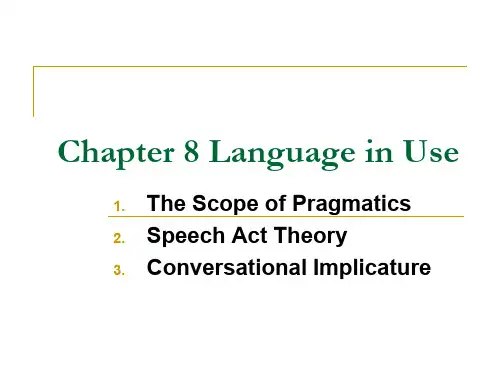
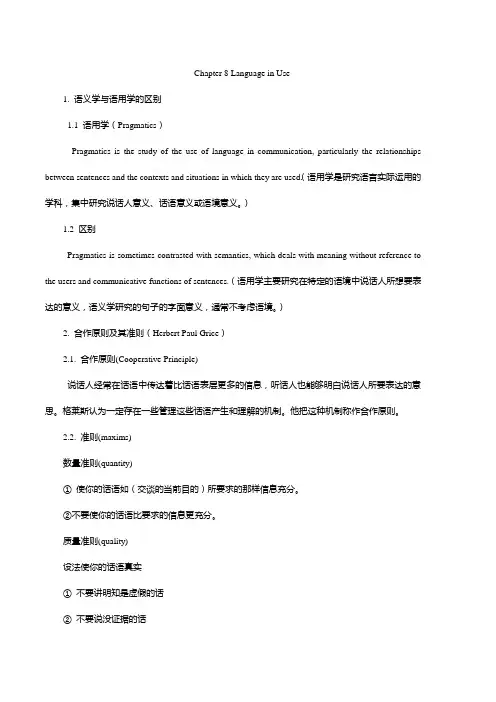
Chapter 8 Language in Use1. 语义学与语用学的区别1.1 语用学(Pragmatics)Pragmatics is the study of the use of language in communication, particularly the relationships between sentences and the contexts and situations in which they are used.(语用学是研究语言实际运用的学科,集中研究说话人意义、话语意义或语境意义。
)1.2 区别Pragmatics is sometimes contrasted with semantics, which deals with meaning without reference to the users and communicative functions of sentences.(语用学主要研究在特定的语境中说话人所想要表达的意义,语义学研究的句子的字面意义,通常不考虑语境。
)2. 合作原则及其准则(Herbert Paul Grice)2.1. 合作原则(Cooperative Principle)说话人经常在话语中传达着比话语表层更多的信息,听话人也能够明白说话人所要表达的意思。
格莱斯认为一定存在一些管理这些话语产生和理解的机制。
他把这种机制称作合作原则。
2.2. 准则(maxims)数量准则(quantity)①使你的话语如(交谈的当前目的)所要求的那样信息充分。
②不要使你的话语比要求的信息更充分。
质量准则(quality)设法使你的话语真实①不要讲明知是虚假的话②不要说没证据的话关系准则(relation)所谈内容要密切相关方式准则(manner)要清晰。
①避免含糊不清②避免歧义③要简练(避免冗长)④要有序3. 言语行为理论(Speech Act Theory)---John Austin3.1. 施为句&叙事句(Performatives & Constatives)施为句是用来做事的,既不陈述事实,也不描述情况,且不能验证真假;叙事句要么用于陈述,要么用于验证,可以验证真假。
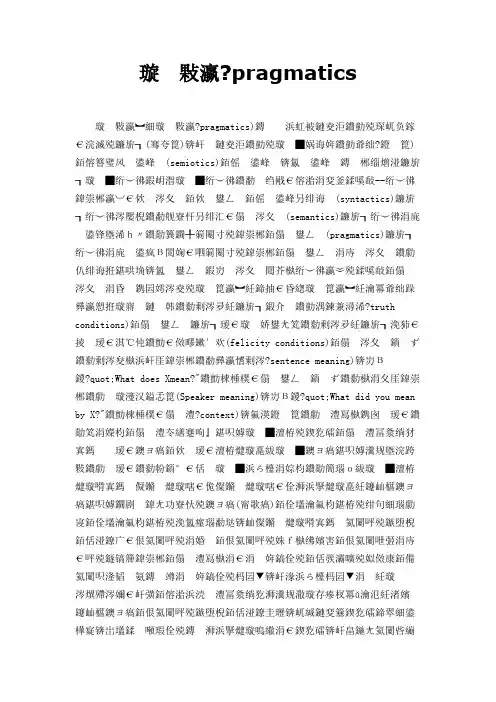
语用学pragmatics语用学:语用学(pragmatics)是对人类有目的的行为所作的研究(广义),对有目的的语言活动的研究(狭义)。
源起符号学(semiotics)。
符号学:符号学是系统地研究语言符号和非语言符号的学科。
有三个分支--符号关系学、语义学、语用学。
符号关系学(syntactics)研究符号之间的形式关系。
语义学(semantics)研究符号与符号所代表的事物之间的关系。
语用学(pragmatics)研究符号与符号解释者之间的关系。
语用学与语义学的联系和区别:语用学和语义学都是符号学的分支。
语义学主要指狭义的语义学,即逻辑语义学,它研究句子和词语本身的意义,研究命题的真值条件(truth conditions)。
语用学研究言语使用上的意义,研究传递语言信息的适宜条件(felicity conditions)。
语义学揭示的意义是二元关系的句子意义(sentence meaning),解决"Whatdoes Xmean?"的问题。
语用学揭示的是三元关系的说话人意义(Speaker meaning),解决"What did you mean by X?"的问题。
语境(context):最狭义的语境是指语言的上下文。
语境还必须包括语言外的因素。
语境因素包括语言知识、语言外知识;语言知识包括对所使用的语言的掌握、对语言交际上文的了解;语言外知识包括背景知识、情景知识、相互知识,背景知识包括百科全书式的知识(常识)、特定文化的社会规范、特定文化的会话规则,情景知识包括交际的时间、地点、交际的主题、交际的正是程度、交际参与者的相互关系。
语境是一个动态的、发展的概念。
交际本身就是一个动态的过程,在交际过程中,语境也随之而变。
有些语境因素相对来说比较稳定,例如背景知识、交际的时间、地点等,但有些因素却会变化,特别重要的是相互知识这一因素,它在交际过程中不断扩大,原来不为双方所共有的知识完全可能在交际过程中变为相互知识,成为进一步交际的基础。
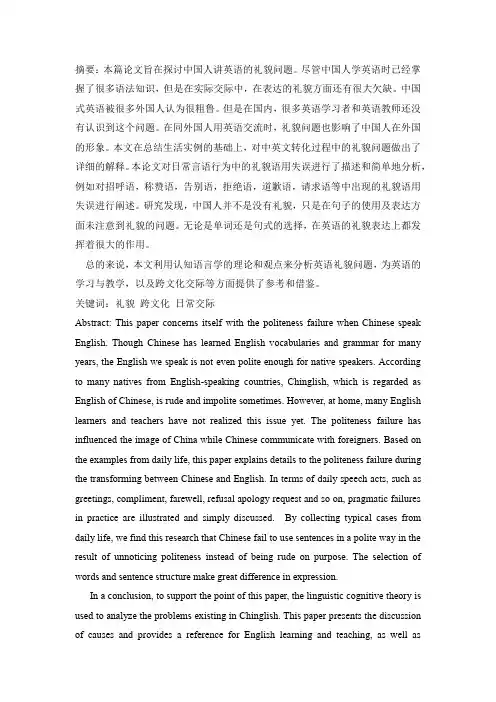
摘要:本篇论文旨在探讨中国人讲英语的礼貌问题。
尽管中国人学英语时已经掌握了很多语法知识,但是在实际交际中,在表达的礼貌方面还有很大欠缺。
中国式英语被很多外国人认为很粗鲁。
但是在国内,很多英语学习者和英语教师还没有认识到这个问题。
在同外国人用英语交流时,礼貌问题也影响了中国人在外国的形象。
本文在总结生活实例的基础上,对中英文转化过程中的礼貌问题做出了详细的解释。
本论文对日常言语行为中的礼貌语用失误进行了描述和简单地分析,例如对招呼语,称赞语,告别语,拒绝语,道歉语,请求语等中出现的礼貌语用失误进行阐述。
研究发现,中国人并不是没有礼貌,只是在句子的使用及表达方面未注意到礼貌的问题。
无论是单词还是句式的选择,在英语的礼貌表达上都发挥着很大的作用。
总的来说,本文利用认知语言学的理论和观点来分析英语礼貌问题,为英语的学习与教学,以及跨文化交际等方面提供了参考和借鉴。
关键词:礼貌跨文化日常交际Abstract: This paper concerns itself with the politeness failure when Chinese speak English. Though Chinese has learned English vocabularies and grammar for many years, the English we speak is not even polite enough for native speakers. According to many natives from English-speaking countries, Chinglish, which is regarded as English of Chinese, is rude and impolite sometimes. However, at home, many English learners and teachers have not realized this issue yet. The politeness failure has influenced the image of China while Chinese communicate with foreigners. Based on the examples from daily life, this paper explains details to the politeness failure during the transforming between Chinese and English. In terms of daily speech acts, such as greetings, compliment, farewell, refusal apology request and so on, pragmatic failures in practice are illustrated and simply discussed. By collecting typical cases from daily life, we find this research that Chinese fail to use sentences in a polite way in the result of unnoticing politeness instead of being rude on purpose. The selection of words and sentence structure make great difference in expression.In a conclusion, to support the point of this paper, the linguistic cognitive theory is used to analyze the problems existing in Chinglish. This paper presents the discussion of causes and provides a reference for English learning and teaching, as well asintercultural communication.Key words: politeness, cross-culture, daily communicationⅠ.IntroductionIn cross-cultural communication, pragmatic failure in politeness has become an essential problem. However, politeness is the key pragmatic principles in language use, especially in the intercultural communication between different groups. Due to some differences in language, culture, and some living environments, politeness in utterances differ dramatically from one community to another community sharing no universal language. In more and more exchanges,trade businesses and other interactive activities among different countries, different polite philosophy has brought various obstacles for inter-cultural communications. Because of those clear discrepancies from different groups,distinct understanding of communication context and other factors that a great number of pragmatic failures in politeness have become the prevailing phenomena in inter-cultural communication.Pragmatic failures in polite utterances are unavoidable. Participants as native speakers and those as non-native speakers encounter all kinds of violation of polite principles.Failures in politeness are most reflected in the speech acts to display the intended meanings and to convey the expected ideas. Therefore, the main issue to be discussed in this thesis is narrowed to the specific pragmatic failures in daily life. Ⅱ.Literature ReviewA.Politeness Study AbroadThe four conversational maxims proposed by Grice in logic and Conversation (1967) are formulated as quantity maxim, quality maxim, relation maxim and manner maxim. Grice advocates these conversational maxims and the Cooperative Principle (CP) to reveal the ways or the mechanisms by which people interpret implicature to accomplish their conversations. His theory has been seen as pragmatic principles in conversations for interpersonal communications.But there is another type of implicature that receives no account in the pragmatic theory of the cooperative principle, which is implicature of politeness. As argued by Thomas (1995), politeness as an illocutionary phenomenon, is closely connected withpragmatics.Following Thomas, we have grouped the pragmatic approach to politeness under four headings: the conversational maxim view advocated by Leech (1980), the face-management view proposed by Brown and Levinson (1987), the conversational-contract view put forward by Fraster (1990)and the pragmatic scales view presented by Spencer-Oatey(1992). Particularly, Leech …s six maxims which include the tact maxim, the generosity maxim, the approbation maxim, the modesty maxim, the agreement maxim and the sympathy maxim are regarded as the politeness principle.According to Leech, communicators generally observe some rules of good behavior which he terms the Politeness Principle. The principle can explain why people are sometimes indirect in conveying what they mean. It is a necessary complement that may rescue the CP from serious trouble in theorizing.B.Politeness Study in Chinathe most worth mentioning is Prof.Gu Yueguo (p237-257),who summarizes four essential elements of Chinese politeness:respectfulness, modesty, attitudinal warmth and refinement. Later on, Gu (1992) elaborates these four essentials into five maxims of politeness in Chinese, They are Self-denigration Maxim; Address Term Maxim; Refinement Maxim; Agreement Maxim; Virtues-word deeds Maxim.C.Studies of Pragmatic Failures AbroadThe notion of pragmatic failure has been initially defined by British linguist Thomas in her paper of cross—cultural pragmatic failure. Thomas defines it as “the inability to understand” what is meant by what is said (Thomas, 1983:p91-112). In other words, it means that the speaker‟s utterance is interpreted or understood by a hearer as different from what the speaker intends to be interpreted. So often pragmatic failure occurs in interactions between native and non-native speakers, and it also can be found in cross-cultural communications between native speakers.D.Studies of Inter-cultural Pragmatic Failure in ChinaChinese famous scholar Mr. He Ziran ( 2002) argues that the umbrella notion of pragmatic failure can refer to any failure that speakers have not accomplished theexpected effect in language communications. He remarks that it is not the wrong grammatical structure that leads to inadequate expression of meaning and sense.Chen Xinren (2004) has also explored pragmatic failures from the aspect of pragmatic competence.He holds that the skills of using language can be seen as pragmatic competence. Language grammar stipulates the correct form and structure of language, and semantic codes regulates that the form must take some meaning or sense.Ⅲ. The pragmatic failure of politeness in daily lifeA.Greeting failureWe are obviously more familiar with some expressions, such as, “hello”, “hi”“I am so sorry”. However, “Good bye” and “See you” is not always equal to the other. Especially when you are a waiter/waitress and the hearer is your customer. The customer can say “See you”when he/she is going to leave. This sentence means he/she likes to be here, and he/she may come here next time. But as a waiter/waitress, using “See you”seems too aggressive; actually, it will make customers feel uncomfortable. The best way, also the simplest way is just say “Bye”.Similarly, “You are welcome” cannot be used to answer every “Thank you”. It sounds too much formal. You can say “Cheers”or “No worry”. If the hearer likes saying “Thank you”, sometimes you can ignore his/her “thanks”and continue your speech. If you are the customer, there is no necessity to say “You are welcome” to the seller. The better way is just say “Thank you” back.According to last two examples, we can clearly see that some expressions in English are not as that familiar to us as what we think of. When we are at school or some other training institutions, we are taught their meanings, but those are the semantic meanings, as for pragmatic meaning, we can only get them from foreigner‟s laughter or contempt. Obviously, that is the reason that most foreigners think Chinese rude and impolite.B.Invitation failureWhen you get a good friend who is an America or British, someday, he says”Would you like to have dinner with me in my house?” Unfortunately, you do not havetime to go there. Some people may say “No, thanks. I have another appointment.”Then, congratulations, you probably will not be invited next time. Or even worse, you just lose a friend. How to say “No” politely is a complex skill no matter in China or abroad. In this condition, “Thanks”cannot make up the hurt you have made. In a polite way, you should say” That is a good idea. I would like to join in, but I have another appointment today.” In this way, you show that you are sorry about not going and give a respect to his/her invitation.C.Request failureIn a restaurant, you want to have a hamburger. You tell the waiter” I want a hamburger”. You are so lucky if he does not treat you like rubbish. It is not a polite way to give a request. Through this way, nothing can even be called “a request”. You should say “Could I have a hamburger, please?”, or “Can I have a hamburger, please?”.D.Euphemism failureWhen British say “I only have a few minor comments”, they mean “Please re-write completely”. But what others understand is “He has found a few typos”. This is a very common phenomenon in daily life. Sometimes, when a British says “Could we consider some other options?”, It means “I do not like your idea” But what others understand is “They have not yet decided.” These two examples show that we cannot get what the British mean completely. Then we should remember more examples.“That is not bad”means “That is good”. “That is very brave”means “That is very stupid” or “You are insane”. “Quite good” means” a bit disappointment”. “Very interesting” means “That is clearly nonsenses”.According to these examples, we can see that if we do not know anything about pragmatics, it is very difficult to get what they actually mean. In this condition, pragmatic failure in politeness is inevitable.Ⅳ. Reason analysis on pragmatic failure in politenessA.Model Verbs(Model Auxil-iaries)The cultured westerners would use model verbs more frequently to show their politeness to others. Therefore, model verbs like “can, could, may, might, and would”will function well in conversations. It sounds more polite to express suggestion, request, willing and so on. For example, “Pass me the salt” is less polite than “Could you please pass me the salt?” apparently.B.Subjunctive moodBy using words like”would rather, would sooner, would as soon”and “had”which is also called as subjunctive mood. It will cause hearer to feel that you are considering a better result or way to avoid the bad ones. It will also show that you are deducing the probable problems and trying to find a way to solve it.C.PleaseWhen “please” goes after the sentence, it sounds better than when it goes before the sentence. Because the sentence sounds like an order when you use “please” as the beginning of a sentence. For example, “Could you please reply to me by Monday? Thank you.” is much more polite than “Please reply to me by Monday. Thank you.”D.Passive voiceSometimes, declarative sentences may be stiff and impolite. This is time to use passive voice or negative sentences or interrogative sentences to show you politeness. In this way, it avoids our subjective opinions and gives the hearer a positive mood. For instance, “Every piece of luggage has to be examined through.” is better than “We will examine every piece of luggage”.E.Past tenseSimilarly, when you use past tense to make a request, it sounds more comfortable and acceptable. For example,”I thought you were needing me, Mr. Smith.”Ⅴ. ConclusionFollowing the definition of pragmatic failures in inter-cultural communication given by Thomas in the 1970s, pragmatic failures in inter-cultural communication has been the hot topic discussed by many scholars more than ever both at home and abroad and many scholars have explored the pragmatic failures from various points of view, such as sociolinguistics, psychology, second language acquisition and so on. This paper mainly investigates the pragmatic failures in politeness, more specificallyin a variety of polite speech acts.The studies of causes of pragmatic failures in inter-language communication can also be applied to those occurring in the politeness and such traditional causes are generalized into four categories as culture and language differences, language transfer in second language acquisition, teaching induced causes and violation of pragmatic rules in language use. But few scholars turn their attention to causes studies in a cognitive approach. That is a reason why this paper is engaged in the exploration of the causes leading to politeness failures in a cognitive perspective.The major causes of politeness failures discussed in this paper are concluded as politeness transfer, different culture-based cognitive environment and an improper choice of context. The study of the causes for politeness failures is on the basis of the common politeness failure phenomena in different speech acts. From a cognitive perspective, prototype and category theory as well as cognitive approach on relevance theory are applied to explain the causes for politeness failures in inter-cultural communication between Chinese and English native speakers.Though, this paper is facilitated with some new perspectives on the analysis of certain causes for politeness failures, there are still some other important causes to generate pragmatic failures, like individual factors, society and others. The focus here is only on three causes, which may be one limitation of this paper. Besides, due to some limitations, no empirical survey is conducted to illustrate the failure phenomenon, and some of those pragmatic failures are collected directly from the books of other scholars, but still they bear pragmatic significance and are scientific enough to be used as evidence in this paper.ReferencesBrown. P & Levinson. S. Politeness: Some Universals in Language Usage. Cambridge: Cambridge University Press, 1987.Leech, G.N. Principles of pragmatics. New York: Longman Group Limited, 1983. Levinson, S.C. Pragmatics. Cambridge: Cambridge University PressThomas, J. Cross-cultural pragmatic failure. Applied Linguistics. London: Oxford University Press, 1983.Yule, G. The Study of Language. Cambridge: Cambridge University Press, 1985陈新仁. 当代语用学. 北京: 外语教学与研究出版社, 2004.何自然. 语用学概论. 长沙: 湖南教育出版社, 2002何伟, 彭漪, 于晖. 当代语言学. 北京: 高等教育出版社,2007顾曰国. “Politeness phenomenon in modern Chinese.”Journal of Pragmatics 141- 990(1993): 237-257.何兆熊.Study of Politeness in Chinese and Eng1ish Cultures. 北京: 北京外国语大学出版社,1995。
